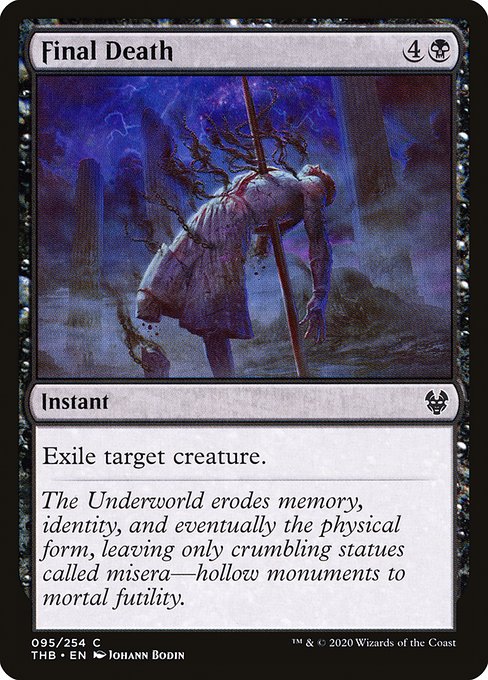
Image courtesy of Scryfall.com
Modeling deck outcomes with a flexible exile spell
When you’re drafting a plan for a black-heavy strategy, the simplest removal spell can be the difference between victory and a narrow defeat. Final Death, an instant from Theros Beyond Death, is a compact but potent tool: for {4}{B} you exile a target creature. In a meta where threats come in waves—from early dwindlers to late-game bomb rares—being able to erase a problem creature from the battlefield and from the graveyard’s reach is a quiet kind of control. 🧙♂️ This card is also a perfect lens for modeling deck outcomes because its value hinges on timing, target pool, and the shape of the opposing board. It’s not about raw tempo alone; it’s about translating probability into a plan that scales with game state. 🔥
What Final Death actually buys you on the board
Exiling a creature is different from simply destroying it. Exile prevents reanimation, recursion, and many graveyard strategies from reclaiming the threat. In formats where graveyard hate or reanimation shenanigans loom, this effect becomes a clutch win condition in slow matchups and a reliable answer in midrange battles. The black color identity mirrors a classic theme in MTG: trading a handful of mana for removal that strategically reshapes the battlefield. The flavor text of Final Death—“The Underworld erodes memory, identity, and eventually the physical form, leaving only crumbling statues called misera”—reminds us that the moment a creature leaves the board, a piece of the game’s narrative is sealed away as well. ⚔️
“A clean exile can be worth more than a flashy board wipe when you’re racing to outlast a stalled draw.”
A practical framework for deck outcomes
To model how Final Death affects win rates, think about multiple layers of decision-making. Here’s a simple, repeatable approach you can apply in your own simulations or limited math exercises. 🎲
- Identify the target pool: What creatures are most threatening in your metagame? In a mono-black shell, you’re likely prioritizing early pressure (3/2s or 4/4s) and late-game bomb threats. The larger the target pool, the higher the expected value of Final Death.
- Estimate timing windows: How often do you have 4 mana available by turns 4–6? In aggressive decks, you’ll want to maximize how often you can cast Final Death by the time the biggest threats appear. The card’s 5 CMC makes it a late-swing option in many fast games—but that’s where timing models shine: you can still catch the late-game cairns that slip through earlier removals. 🔥
- Account for exile vs. destruction: Exiling a creature also prevents graveyard-based combos. If your opponent relies on flashback, escape, or resurrection tricks, Final Death’s exile effect raises the value of this single play. In your simulations, mark the differential impact between “destroy” and “exile” outcomes in terms of reanimation risk reduction. ⚔️
- Factoring format legality and interaction: Final Death is legal across many formats (historic, modern, legacy, etc.), and even in some casual or duel contexts. If you’re modeling deck outcomes for Commander or other constructed formats, include the potential for *synergies with graveyard hate or multisource removal* to skew probabilities in your favor. 🧠
- Incorporate variability of draw steps: The value of a late-game exile depends on when you draw it. A quick, probabilistic model will weight early draws less than mid-to-late draws, reflecting how the card’s impact grows as the game unfolds. 🎨
Design implications for black-based decks
Final Death is a compact piece in a larger puzzle. In a deck that leans into hand disruption, discard outlets, and graveyard interaction, this exile spell can be scheduled as a “reset button” when the terrain grows volatile. It’s especially potent in boards where creatures outclass your early removal or where a single returned threat can swing the game. You’ll find that the card’s placement on the curve—costing four mana for a one-shot exile—often encourages you to orchestrate a midrange plan: pressure early with efficient creatures, then flip the switch to secure the late-game by answering the opposing top threats. 💎
As a lasting design note, Final Death’s simplicity is its strength. It doesn’t require a complicated setup, yet it interacts meaningfully with decks that lean into graveyard play, reanimation, or delve into the underworld’s themes. The black color identity’s affinity for efficient answers lands squarely in its wheelhouse. For players who enjoy crunching numbers and plotting outcomes, this spell is a delightful focal point for a broader probabilistic strategy. 🧙♂️
Flavor, art, and the tactile side of MTG collecting
Beyond its mechanical utility, Final Death offers a narrative bite. The art by Johann Bodin and the Theros Beyond Death frame evoke a ritual of removing a creature and sealing its fate beyond recall. The rarity is common, which makes it accessible for budget strategies, yet the foil variants and nonfoil prints invite collectors to chase a few glossy versions. The card’s market motion—low price points in the near-term with potential for surprise spikes—also makes it a nice case study for rarity psychology in MTG, a topic we’ll explore further in our linked features. 🎲
Integration with a cross-promotional moment
While comparing deck outcomes, it’s fun to weave in real-world connections. If you’re exploring a multi-format approach or a brand collaboration, consider how a card like Final Death mirrors a broader strategy: precise, elegant, and cost-effective control that tightens the hinge on a game’s late turns. And if you’re shopping while you read, check out the product link below for a stylish, practical accessory—a reminder that the MTG journey combines strategy, storytelling, and a little everyday flair. 🔥
Slim Glossy Phone Case for iPhone 16 Lexan PCMore from our network
- https://crypto-acolytes.xyz/blog/post/stablecoins-vs-meme-coins-understanding-polar-opposites/
- https://blog.digital-vault.xyz/blog/post/wind-strider-reading-market-signals-before-major-reprints/
- https://transparent-paper.shop/blog/post/unveiling-space-magnitudes-through-a-hot-thirty-thousand-kelvin-star/
- https://blog.digital-vault.xyz/blog/post/rarity-psychology-in-mtg-stronghold-arena-spotlight/
- https://transparent-paper.shop/blog/blog/post/creating-project-planning-dashboards-a-practical-guide/